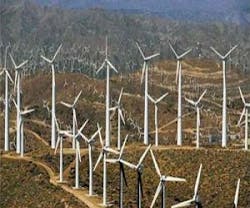Wind Farms and the Night-Warming Effect
As renewable energy sources are implemented as options at facilities and buildings across the U.S., new insights are continually discovered. A study led by Liming Zhou, an atmospheric scientist at the State University of New York- (SUNY) Albany, provides insights about the possible effects of wind farms. According to Zhou, wind farms in certain areas in the United States appear to affect local land surface temperatures
The results could be important for developing efficient adaptation and management strategies to ensure long-term sustainability of wind power.
"This study indicates that land surface temperatures have warmed in the vicinity of large wind farms in west-central Texas, especially at night," says Anjuli Bamzai, program director in the National Science Foundation's (NSF) Division of Atmospheric and Geospace Sciences, which funded the research.
"The observations and analyses are for a relatively short period, but raise important issues that deserve attention as we move toward an era of rapid growth in wind farms in our quest for alternate energy sources."
o understand the potential impact of wind farms on local weather and climate, Zhou's team analyzed satellite-derived land surface temperatures from regions around large wind farms in Texas for the period 2003-2011.
The researchers found a night-time warming effect over wind farms of up to 0.72 degrees Celsius per decade over the nine-year-period in which data were collected.
Because the spatial pattern of warming mirrors the geographic distribution of wind turbines, the scientists attribute the warming primarily to wind farms.
The year-to-year land surface temperature over wind farms shows a persistent upward trend from 2003 to 2011, consistent with the increasing number of operational wind turbines with time.
"This warming effect is most likely caused by the turbulence in turbine wakes acting like fans to pull down warmer near-surface air from higher altitudes at night," says Somnath Baidya Roy of the University of Illinois at Urbana-Champaign, a co-author of the paper.
